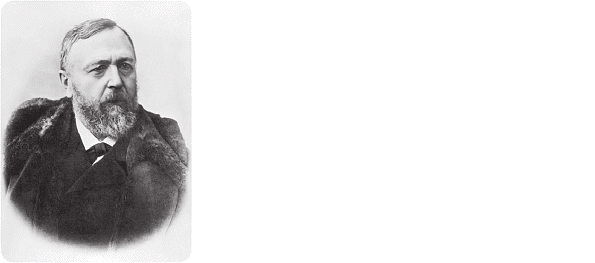FRIDAY, DAY 5
SEXUALITY AND REPRODUCTION
Krafft-Ebing
When it comes to sex, the German neuropsychiatrist Richard Baron von Krafft-Ebing (1840–1902) wrote the book—literally. In 1886, he published Psychopathia Sexualis, a groundbreaking study of sexual deviance. Intending the work as a reference for physicians and forensic scientists, Krafft-Ebing documented the most sordid details in Latin to discourage lay readers. Still, the book became commercially popular, going on to publish 12 editions.

In his work, Krafft-Ebing detailed 45 case studies of sexual aberrations ranging from impotence to necrophilia and grouped them into three categories: hyperaesthesia (an abnormally exaggerated sexual instinct), anaesthesia (an absence of sexual instinct), and paraesthesia (perversion of the sexual instinct). In describing the patients, Krafft-Ebing introduced to the general public numerous terms that have lasted until today, such as heterosexual, homosexual, and fetishism. He also coined the words sadism, after the libertine French author Marquis de Sade (1740–1814), and masochism, after the Austrian novelist Leopold von Sacher-Masoch (1836–1895), whose characters often gained sexual pleasure from experiencing pain and humiliation.
Besides introducing society to these titillating topics, Psychopathia Sexualis also established a connection between sexuality and biology. Although the main line of thinking at the time was that sexual deviance was due to insanity or the devil’s work, Krafft-Ebing suggested that sexual behavior was governed by the brain and spine and that genetics played a role.
Beyond the study of sex, Krafft-Ebing made many contributions to the field of psychiatry. He popularized forensics and hypnosis, among other disciplines. Krafft-Ebing also made psychiatric treatments more palatable to the middle and upper classes, by founding a suburban sanatorium for the “nervous.”
ADDITIONAL FACTS
- At the age of 32, Krafft-Ebing became a professor of psychology at the Universities of Strasbourg in France.
- The famed psychologist Carl Jung (1875–1961) was near the end of his studies in archaeology when he read Psychopathia Sexualis, which inspired him to switch to psychology.
- Krafft-Ebing earned a medical degree from the University of Heidelberg in Germany.